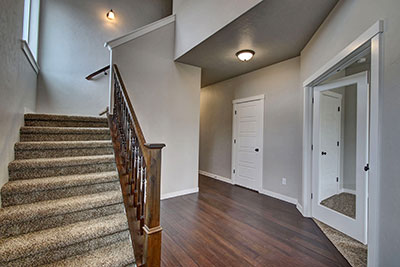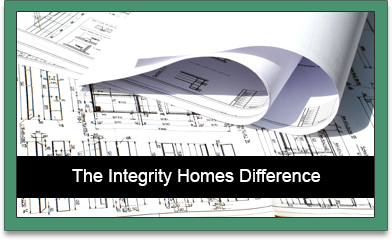
Our Process
THE HOME BUILDING PROCESS FROM DESIGN TO LIVING IN YOUR NEW HOME Knowing your home building process helps you make informed decisions about the design and style of your future home.
Knowing your home building process helps you make informed decisions about the design and style of your future home.
Have you ever wondered exactly how a new home is built and what steps are taken along the way? After all, a finished house has many layers to it, including the foundation, walls, and roof.
There are also interior “layers” such as plumbing, electrical systems, heating, and finish detail. All these layers must somehow be put together, one-by-one, during the building process. Some of these steps must be followed up with an inspection.
Here are the basic steps that a reputable builder will go through during the home building process:
1. YOU AND YOUR BUILDER DESIGN YOUR HOME.
The home building process begins with designing your future home and creating a home you will love to live in. Arguably, this is the most important phase of home construction and involves making critical decisions about your wants and needs, the floor plan, and selection of materials.
As the future homeowner, you should take some time to look over your home design options and voice any and all questions and concerns with your builder. Also, a reputable builder should outline the design process for you.
2. YOUR HOME SITE IS PREPARED AND THE FOUNDATION POURED.
Depending on the terrain, such as if the lot is wooded or rocky, a crew clears your future home site using bulldozers and/or backhoes. The site is excavated for the footings – these are the structures where the house meets the ground and supports the foundation walls.
After the footings are installed, forms for the foundation walls are set on the footings and the foundation walls are poured into the forms. The forms are removed from the walls and the concrete is allowed to “cure”. A waterproofing membrane is then applied to those walls.
During this stage of construction, underground water and sewer lines are installed, as well as any plumbing rough-ins that will be included in the basement.
Inspections are performed by city and/or county inspectors after the footings are in place and then again after the foundation is poured. If everything is judged to be in compliance with building codes and setbacks, the construction proceeds.
3. YOUR HOUSE IS ROUGH FRAMED.
The framing is the “skeleton” of your house.
The “skeleton” of your house, which is called the rough framing, is put up. This includes the installation of posts and beams and then floor joists, for example, as well as the trusses and/or rafters that make up your roof support.
Plywood or OSB sheathing is then applied to the exterior side of your home’s walls and roof. That sheathing is eventually covered by a protective barrier called house wrap; Tyvek® is a commonly seen commercial example of such house wrap.
This covering protects the house skeleton from exterior moisture while still allowing interior water vapor to escape. Such wrapping reduces the risk of mold and rot. Windows and exterior doors are also installed at this point.
After the wrapping is finished, the house “skins” can be installed, including its siding and roofing.
4. PLUMBING, ELECTRICAL/MECHANICAL AND HVAC SYSTEMS ARE INSTALLED.
Now that the house is “dried-in” and with the house interior walls still exposed, plumbing contractors can easily install sewer lines and vents, and water supply lines and pipes. Bathtubs and shower surrounds may also be placed at this time because there is more space available for moving large objects.
HVAC contractors will install supply and air returns for the heating, cooling and ventilation of the house at this time.
Finally, electrical contractors will input breaker panels and run electrical lines along the joists and walls of your house.
After these rough-ins are complete, the home will undergo framing, plumbing, HVAC, & electrical inspections by your city/county building inspector.
5. THE DRYWALL AND INTERIOR TRIM IS INSTALLED.
Drywall, which might also be called plasterboard, wallboard, gypsum board, or the trademarked name Sheetrock®, is delivered to and installed in your home. After the drywall is installed, its edges are taped and mudded so that open seams are not visible. Additional drywall texturing is applied. Finally, a coat of primer and paint is applied.
Hard surface flooring is then installed, followed by cabinets, interior doors and base trim, casings and moldings.
Our Process (continued)
6. DRIVEWAYS AND SIDEWALKS ARE POURED.Assuming no further heavy equipment will need to be placed by your home, the exterior walkways, including sidewalks and patios, are formed and poured. The driveway is also formed and poured at this time.
7. THE COUNTERTOPS ARE INSTALLED.
Kitchen and bathroom countertops are added. The exterior grading is checked to ensure that water will be draining away from the house, and sod or grass seeding and other landscaping work is begun.
8. LIGHTING AND BATH FIXTURES ARE INSTALLED.
At this point, the electrician installs the light fixtures and switches inside of your house and tests them for functionality.
Bathroom and kitchen fixtures such as the toilets, sinks and faucets are installed, along with the HVAC registers on supply and air returns.
9. MIRRORS AND SHOWER DOORS ARE INSTALLED.
Delicate items such as mirrors and glass shower doors are hung. The last finish item to go in is the carpet to assure it stays clean. The landscaping is finished and general cleanup begins.
At this point, a final inspection is conducted and the inspector issues the builder a certificate of occupancy (C.O.O.), which means that the house is now considered livable and is ready to move in.
10. FINAL WALK-THROUGH.
You and your builder do a walk-through of your newly finished house and its features are described and demonstrated to you. Your builder also provides all manufacturers’ warranties. At this point, you and your builder may also make up a punch list of any minor details that your builder needs to address. You should also voice any questions or concerns to your builder at this time so that any issues can be resolved. A reputable builder will provide a good warranty program to address any issues that come up after you move in.
At Integrity Homes & Design, our warranty service program ensures timely, professional service of warranty issues. We actually contact you at several set time-points during your first year in your new home to make sure everything in your home is functioning as it should.
Whether it is your first time building or you have experience building homes, planning is the most important phase. While the construction of your home may take 3 to 6 months (depending on size and complexity), the planning and design phase may take 1-2 months. The planning, design, and construction phases are very important, but another very important phase is after you move in. The peace of mind knowing your builder will be there to address any and all issues that come up is perhaps the most important piece.







 Integrity Homes & Design
Integrity Homes & Design